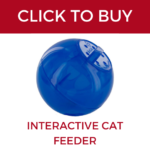
Feeding Your Cat for Health and Happiness
Most cat owners are feeding their cats the wrong way, eventually leading to major health and behavior problems that stem from obesity and boredom. Overweight or obese cats are at much greater risk for type 2 diabetes, severe constipation, arthritis pain, hygiene deficits, and urinary tract disease, and house soiling associated with those problems. Obesity also increases the risk for pancreatitis, heart failure, and cancer.
Most dry foods and many wet foods are much lower in protein and higher in carbohydrates than the prey cats are designed to eat. These extra carbs can cause blood sugar spikes and sluggishness, which promote insulin resistance and fat deposition. Excessive fat produces hormones that disrupt the normal regulation of appetite, metabolism, and activity. This promotes further inactivity, inappropriate hunger, and fat deposition.
What Can You Do to Help Your Cat Lose the Weight?
Feed More Low-carb Kibble
Cats in the wild snack mostly on high-protein prey which in turn metabolizes much faster than their high-carb kibble. Whenever you change your pet’s food, remember to do it gradually over the course of a week or so in order not to shock your pet’s digestive system.
Plan to Reduce Gradually
Sudden and drastic reductions in food intake can not only cause begging but can also cause fatty liver disease in obese cats. Plan to decrease total daily kibble by only .5 to 1 tablespoon each week until at the recommended serving size.
Multiple Cats
If you have more than one cat that needs to reduce to a healthy weight, plan to consistently feed them in their own special spots. The meals should be small enough, and the cats spaced far enough apart, that each cat can finish before the other can try to steal.
Feed Small Meals Throughout the Day
If a small meal for a cat (average mouse) is 30 calories, a cat would need to catch six to seven small meals daily. Outdoor cats also snack on insects between meals. Cats may only catch 10-20% of the prey they stalk, so they are programmed to be constantly on the lookout for prey and would naturally spend 12 hours a day hunting. Since this is the cat’s natural instinct, they benefit from several small meals a day, rather than one or two larger meals.
Prolong the Time Your Cat Spends Eating
Yes, that’s right. Since a cat would spend about 2 minutes stalking, catching, and eating prey, they tend to want to spend approximately 2 minutes eating kibble as well. You can prolong the process without increasing the amount of food. You can do this by making or purchasing a cat food puzzle, hiding or stashing kibble around the house, or even distribute a few pieces of kibble throughout a room and lead the cat to each pile with a laser pointer. This increases activity while also prolonging the act of eating.


